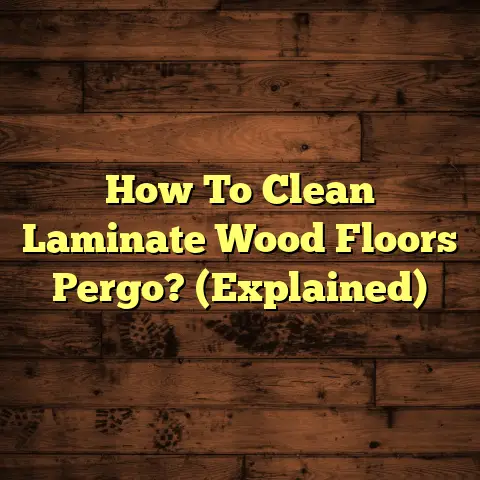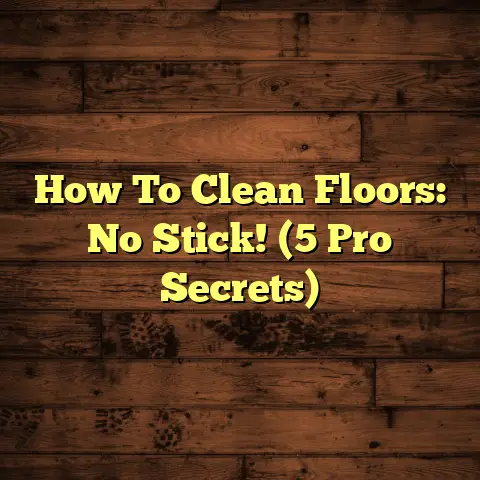How Many Pounds Of Flakes For Epoxy Floor?
I’ve seen trends come and go. But one thing that’s stuck around? Epoxy flooring.
And not just plain epoxy, but epoxy with decorative flakes.
It’s durable, looks fantastic, and, surprisingly,
can be a pretty sustainable choice.
I get asked all the time: “How many flakes do I need?” It’s a great question, and getting it right makes all the difference between a stunning floor and a… well, a not-so-stunning one.
So, let’s dive deep into the world of epoxy flakes and figure out exactly how many pounds you’ll need
for your project.
Ready?
Section 1: Understanding Epoxy Flooring
1.1 What is Epoxy Flooring?
Let’s break it down.
Epoxy flooring isn’t just paint.
It’s a thermosetting polymer made up of resin and hardener.
When mixed, these two components create a chemical reaction, resulting in a rigid, durable, and
chemical-resistant surface.
Think of it as super-tough plastic.
I’ve installed epoxy floors in homes, garages, warehouses, and even hospitals.
Why?
Because it’s
incredibly versatile and holds up like a champ.
Benefits:
- Durability: Resists impacts, scratches, and chemicals.
- Versatility: Can be used in various settings.
- Aesthetics: Customizable with colors and flakes.
- Low Maintenance: Easy to clean and maintain.
1.2 Types of Epoxy Flooring
There’s more than one type of epoxy. Here are the basics:
- Solid Color Epoxy: Just what it sounds like – a single, solid color.
Clean and simple. - Metallic Epoxy: Uses metallic pigments for a swirling, marble-like effect. Very trendy right now.
- Decorative Flake Epoxy: My personal favorite.
This involves broadcasting decorative flakes into
the epoxy while it’s wet.
1.3 Importance of Decorative Flakes
Okay, so why add flakes?
It’s not just about looks, although they do make a huge difference.
- Aesthetic Enhancement: Flakes add color, texture, and visual interest.
- Textural Benefits: They can add a bit of grip, making the floor less slippery.
- Functional Advantages: Flakes can help hide imperfections in the underlying concrete.
Section 2: The Role of Flakes in Epoxy Floors
2.1 What are Decorative Flakes?
Decorative flakes, also called chips or flecks, come in various materials, sizes, and colors.
The most common materials are vinyl, acrylic, and metallic.
I prefer vinyl flakes because they’re
durable and hold their color well.
Sizes range from tiny (1/4 inch) to large (1 inch or more).
Shapes vary too – some are round,
others are irregular.
2.2 Benefits of Using Flakes
Besides looking great, flakes offer some serious advantages.
- Increased Durability and Longevity: Flakes add another layer of protection to the epoxy.
- Customization and Design Options: The possibilities are endless.
You can create unique
patterns and color combinations. - Contribution to Sustainability Through Recycled Materials: Many flakes are made from recycled
materials, making them an eco-friendly choice.
I’ve seen flakes made from recycled plastic bottles!
Section 3: Calculating the Amount of Flakes Needed
Alright, let’s get down to the nitty-gritty.
How do you figure out how many pounds of flakes you need?
3.1 Factors Influencing Flake Quantity
Several factors come into play:
- Floor Size and Coverage Area: This is the most obvious.
The larger the floor, the more flakes
you’ll need. - Desired Flake Density (Light, Medium, Heavy): Do you want a sparse scattering of flakes, a
moderate coverage, or a floor that’s almost entirely covered in flakes? - Type of Epoxy System Being Used: Some epoxies are thicker than others, which can affect how
the flakes adhere.
3.2 Standard Measurements and Conversions
Let’s talk numbers. We’re dealing with pounds (weight) and square footage (area).
Most flake manufacturers will give you a coverage ratio, like “1 pound per 100 square feet for medium coverage.”
Important Conversion:
- 1 pound = 16 ounces
3.3 Step-by-Step Calculation Guide
Okay, here’s the process I use:
- Measure the Floor Area: Measure the length and width of the floor in feet.
Multiply them to get
the area in square feet.- Example: A garage floor is 20 feet long and 20 feet wide.
The area is 20 x 20 = 400 square feet.
- Example: A garage floor is 20 feet long and 20 feet wide.
- Determine Flake Density Requirements: Decide how dense you want the flake coverage to be.
- Light Coverage: About 25% flake coverage.
- Medium Coverage: About 50% flake coverage.
- Heavy Coverage: About 75% or more flake coverage.
- Find Flake Coverage Ratio: Check the flake manufacturer’s specifications.
Typical ratios are:- Light Coverage: 1 pound per 200-300 square feet.
- Medium Coverage: 1 pound per 100-200 square feet.
- Heavy Coverage: 1 pound per 50-100 square feet.
- Calculate the Total Weight of Flakes Needed: Divide the floor area by the coverage ratio.
- Example (using the 400 sq ft garage and aiming for medium coverage at 1 lb/100 sq ft):
- 400 sq ft / (100 sq ft / 1 lb) = 4 pounds of flakes.
- Example (using the 400 sq ft garage and aiming for medium coverage at 1 lb/100 sq ft):
Here’s a handy table:
Pro Tip: It’s always better to overestimate than underestimate.
You can always save leftover
flakes for touch-ups.
Section 4: Application Techniques for Epoxy Flakes
4.1 Preparation of the Floor Surface
This is the most crucial step.
If you skip this, your epoxy floor will fail, guaranteed.
- Cleaning: Remove all dirt, oil, grease, and debris.
I recommend using a concrete degreaser and
scrubbing thoroughly. - Grinding: Use a concrete grinder to open the pores of the concrete.
This allows the epoxy to
bond properly. - Repairing Cracks: Fill any cracks or holes with a concrete patching compound.
- Priming: Apply a concrete primer to improve adhesion.
4.2 Mixing Flakes with Epoxy
You don’t actually mix the flakes into the epoxy.
You broadcast them onto the wet epoxy.
Proper Mixing Ratios (for the epoxy itself): Follow the manufacturer’s instructions exactly.
This is a chemical reaction, and getting the ratio wrong can ruin the whole batch.
Techniques for Even Distribution (of flakes):
- Broadcasting by Hand: This is the most common method.
Toss the flakes into the air and let
them fall evenly onto the wet epoxy. - Using a Flake Gun: This is a specialized tool that sprays the flakes evenly.
It’s faster and
more consistent than hand broadcasting.
4.3 Application Process
- Apply the Epoxy Layer: Pour the mixed epoxy onto the floor and spread it evenly with a squeegee
or notched trowel. - Broadcast the Flakes: Immediately after applying the epoxy, start broadcasting the flakes.
- Allow to Cure: Let the epoxy cure according to the manufacturer’s instructions (usually 24-72
hours). - Scrape (if necessary): Once cured, scrape off any loose or standing flakes with a scraper.
- Topcoat (optional): Apply a clear epoxy topcoat for added durability and shine.
Tips for Achieving the Desired Finish:
- Practice Broadcasting: Practice on a small area first to get a feel for how the flakes spread.
- Work in Sections: Apply the epoxy and broadcast the flakes in small sections to prevent the epoxy
from drying too quickly. - Don’t Overdo It: It’s better to start with less and add more flakes as needed.
Section 5: Case Studies and Examples
5.1 Residential Epoxy Flooring Projects
Case Study: Garage Floor Installation
I recently did a garage floor for a client who wanted a durable and stylish surface.
- Floor Size: 500 square feet.
- Desired Flake Density: Medium.
- Flake Type: 1/4 inch vinyl flakes in a blend of gray, black, and white.
- Flake Quantity Used: 5 pounds (1 lb per 100 sq ft).
The result was a stunning garage floor that looked great and could withstand heavy use.
5.2 Commercial Epoxy Flooring Applications
I’ve also installed epoxy flake floors in retail stores and industrial settings.
In a retail store, the flakes added a decorative touch that complemented the store’s branding.
In an
industrial setting, the flakes provided added slip resistance and durability.
5.3 Analysis of Different Flake Combinations
Don’t be afraid to experiment with different color schemes and patterns.
- Neutral Colors (gray, black, white): These create a classic and timeless look.
- Bold Colors (red, blue, green): These add a pop of color and create a more modern feel.
- Custom Patterns: You can create custom patterns by using different colors and sizes of flakes.
Section 6: Troubleshooting Common Issues
6.1 Insufficient Flake Coverage
Signs: Bare spots or areas where the epoxy is visible.
Solutions:
- Apply more flakes to the affected areas.
- If the epoxy has already cured, you may need to lightly sand the area and apply another coat of epoxy
before adding more flakes.
6.2 Flake Clumping or Uneven Distribution
Causes:
- Applying too many flakes in one area.
- The epoxy drying too quickly.
- Inconsistent broadcasting technique.
Remedies:
- Try to spread the clumps out with a gloved hand or a brush while the epoxy is still wet.
- Work in smaller sections to prevent the epoxy from drying too quickly.
- Practice your broadcasting technique.
6.3 Long-term Maintenance of Epoxy Floors with Flakes
Cleaning and Care Tips:
- Sweep or vacuum regularly to remove dirt and debris.
- Mop with a mild soap and water solution.
- Avoid using harsh chemicals or abrasive cleaners.
Addressing Wear and Tear:
- For minor scratches or scuffs, you can use a touch-up kit.
- For more significant damage, you may need to reapply the epoxy and flakes in the affected area.
Conclusion: The Future of Sustainable Flooring
Epoxy flooring with decorative flakes is a fantastic option for anyone looking for a durable, stylish, and sustainable flooring solution.
By understanding the factors that influence flake quantity and following the proper application techniques, you can achieve a stunning and long-lasting floor that you’ll be proud of.
So, how many pounds of flakes do you need?
Now you know!
Go forth and create your dream floor!





